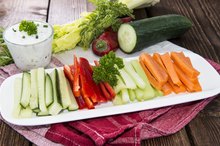Healthy Balanced Diet for a 5-Year-Old
Proper nutrition is essential to your child’s health. Three well-balanced meals each day that include lean meats, fruits and vegetables, and low-fat dairy products may prevent your 5-year-old from developing health conditions such as osteoporosis later in life. In addition, physical activity should be included in your child’s daily routine to reduce the chances of her being overweight. According to Baylor College of Medicine, an average 5-year-old typically needs about 40 calories per pound of body weight. Always speak with your child’s pediatrician prior to changing her diet.
Breakfast
Breakfast is the most important meal of the day for you and your child. Children who eat healthy well-balanced meals get the daily nutritional needs to help keep their weight under control, maintain lower blood-cholesterol levels and complain of fewer stomach aches. Additionally, eating breakfast helps in fueling the body throughout the day. Whole wheat toast, cereal with low-fat milk and fruit are all good sources of morning nutrition. This combination of foods may be served as a wholesome meal for your child or may be served individually with milk.
- Breakfast is the most important meal of the day for you and your child.
- Children who eat healthy well-balanced meals get the daily nutritional needs to help keep their weight under control, maintain lower blood-cholesterol levels and complain of fewer stomach aches.
Whole Grains
Eating Plan for a 15-Year-Old Girl
Learn More
There are two types of grains. Whole grains and refined grains. Refined grains have been refined, which in turn removes all the nutrients from them. Once they have been refined, the nutrients are replaced with synthetic vitamins and minerals. Therefore, it is best to avoid these types of grains; white breads, pasta and sugar are all sources of refined grains. Whole grains consist of whole wheat breads, oats, bran, fiber and barley. The recommended daily grain intake for a 5-year-old is 4 to 5 oz.
- There are two types of grains.
- Therefore, it is best to avoid these types of grains; white breads, pasta and sugar are all sources of refined grains.
Fruits and Vegetables
Fruits and vegetables are a good source of vitamins, minerals and fiber and are low in calories. Vitamins such as vitamin C are one of the most essential vitamins, as it protects your cells from oxidation. Citrus fruits are good sources of vitamin C. Vitamin D aids in the absorption of magnesium and calcium and is necessary for strong bones and teeth. Healthy well-balanced diets will provide your 5-year-old with adequate vitamin and mineral intake. Including fruits such as bananas with your child’s breakfast is a good way to start the day. The average 5-year-old needs five servings of fruits and vegetables daily.
- Fruits and vegetables are a good source of vitamins, minerals and fiber and are low in calories.
- Citrus fruits are good sources of vitamin C. Vitamin D aids in the absorption of magnesium and calcium and is necessary for strong bones and teeth.
Lean Meats
What Is a Balanced Diet for a Growing Teenage Boy or Teenage Girl?
Learn More
Protein is essential in the building, function and maintenance of your muscles and body tissues. Meats are a good source of protein, iron and vitamin B. Iron is necessary for your body to transport oxygen to the cells of your body, while B vitamins are needed for energy and a healthy heart and nervous system. Your 5-year-old needs 3 to 4 oz. of lean meat daily.
- Protein is essential in the building, function and maintenance of your muscles and body tissues.
- Meats are a good source of protein, iron and vitamin B.
- Iron is necessary for your body to transport oxygen to the cells of your body, while B vitamins are needed for energy and a healthy heart and nervous system.
Low-Fat Dairy
Your body relies on calcium and vitamin D for strong bones and teeth. In addition, dairy products provide protein. Low-fat dairy products such as milk, cheeses and yogurt are good sources of calcium for your child. KidsHealth states that the recommended daily amount of dairy products for a 5-year-old is 2 cups.
- Your body relies on calcium and vitamin D for strong bones and teeth.
- Low-fat dairy products such as milk, cheeses and yogurt are good sources of calcium for your child.
Related Articles
References
- Kumar P, Yadava RK, Gollen B, Kumar S, Verma RK, Yadav S. Nutritional contents and medicinal properties of wheat: a review. Life Sciences Med Res. 2011;LSMR-22.
- USDA ChooseMyPlate. All about the grains group.
- Wang T, Zhan R, Lu J, et al. Grain consumption and risk of gastric cancer: a meta-analysis. Int J Food Sci Nutr. 2020;71(2):164-175. doi:10.1080/09637486.2019.1631264
- Li H, Mao H, Yu Y, Nan Y. Association between dietary fiber and endometrial cancer: a meta-analysis. Nutr Cancer. 2019;1-9. doi:10.1080/01635581.2019.1670218
- Kashino I, Eguchi M, Miki T, et al. Prospective association between whole grain consumption and hypertension: The Furukawa Nutrition and Health Study. Nutrients. 2020;12(4). doi:10.3390/nu12040902
- Wang Y, Duan Y, Zhu L et al. Whole grain and cereal fiber intake and the risk of type 2 diabetes: a meta-analysis. Int J Mol Epidemiol Genet. 2019;10(3):38-46.
- Reynolds AN, Akerman AP, Mann J. Dietary fibre and whole grains in diabetes management: Systematic review and meta-analyses. PLoS Med. 2020;17(3):e1003053. doi:10.1371/journal.pmed.1003053
- Ross AB, Bruce SJ, Blondel-Lubrano A, et al. A whole-grain cereal-rich diet increases plasma betaine, and tends to decrease total and LDL-cholesterol compared with a refined-grain diet in healthy subjects. Br J Nutr. 2011;105(10):1492-502. doi:10.1017/s0007114510005209
- Costabile A, Klinder A, Fava F, et al. Whole-grain wheat breakfast cereal has a prebiotic effect on the human gut microbiota: a double-blind, placebo-controlled, crossover study. Br J Nutr. 2008;99(1):110-20. doi:10.1017/S0007114507793923
- Martínez I, Lattimer JM, Hubach KL, et al. Gut microbiome composition is linked to whole grain-induced immunological improvements. ISME J. 2013;7(2):269-80. doi:10.1038/ismej.2012.104
- Tieri M, Ghelfi F, Vitale M, et al. Whole grain consumption and human health: an umbrella review of observational studies. Int J Food Sci Nutr. 2020;1-10. doi:10.1080/09637486.2020.1715354
- National CACFP Association. Identifying whole grain-rich.
Writer Bio
Michelle Lawson began her professional writing career in 2010, with her work appearing on various websites. She emphasizes alternative approaches to health-related issues. She is certified as a Sports Nutritionist by the International Fitness Association. Lawson graduated from ATI College of Health with honors, earning her associate degree in medical assisting.









